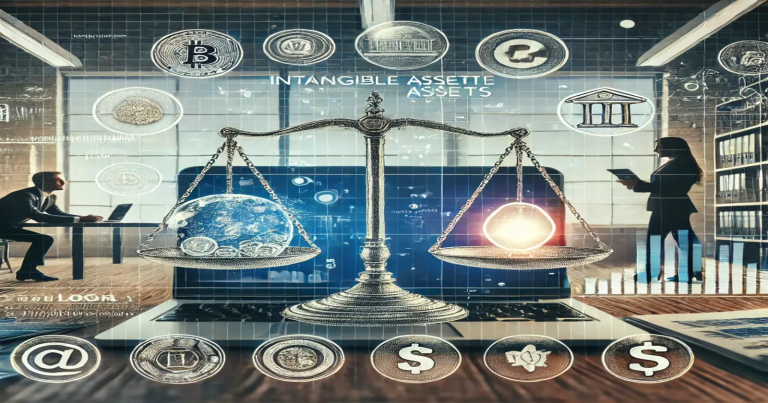Understanding how to determine the valuation of intangible assets is important for every business owner, accountant, and finance student. Intangible assets are not physical like land or machinery. But they still carry great value. These can include brand names, goodwill, patents, copyrights, and trademarks. Companies need to know their value during mergers, acquisitions, and financial reporting. So, valuation of intangible assets tells us how much these assets are worth in money terms. Intangible assets help businesses stay strong in the market. They build identity and trust. Think of Google’s brand name or Coca-Cola’s secret formula. These are not seen but have massive value. Knowing their worth helps during selling a business, getting loans, or even attracting investors. In India, the importance of valuation of intangible assets in India has grown. More businesses use it during audits, investments, and for legal needs.
What is Valuation of Intangible Assets?
Valuation of intangible assets means finding out how much a non-physical asset is worth. These assets don’t have shape or size, but they add value to a business. When businesses sell, merge, or show assets in financial reports, they need to know the true worth of these items.Following are the major types of Intangible Assets:
- Goodwill: The extra money paid during business purchases because of reputation.
- Brand Name: Popularity and trust connected to the company name.
- Trademarks: Legal rights to use a brand symbol or logo.
- Copyrights: Rights to creative works like music or books.
- Patents: Exclusive rights to make or sell an invention.
These assets help in increasing profits and customer loyalty. But since we can’t touch or see them, their value is hard to measure. That’s where valuation of intangible assets plays a key role.
Why Do We Need Valuation?
Businesses need to show correct values in balance sheets. Investors want to know the worth of such assets. Government bodies, tax departments, and even courts ask for these values during legal matters. Also, during mergers or acquisitions, companies must agree on the price of such assets.In India, proper valuation of intangible assets in India follows guidance by ICAI (Institute of Chartered Accountants of India) and SEBI regulations. More businesses now perform such valuations to meet legal and financial needs.
We need valuation of intangible assets for the following reasons in business:
- Mergers and Acquisitions: Buyer and seller must agree on the total value.
- Financial Reporting: Firms show these assets in balance sheets.
- Raising Funds: Investors want to know what they’re paying for.
- Selling a Business: The seller needs to quote the right price.
- Legal Disputes: Courts ask for fair market value of these assets.
- Tax Purposes: You must declare values for GST and Income Tax.
For example, if a brand like Ola wants to raise funds, investors will check its app, user base, and brand strength. All of these are intangible assets. That’s why valuation of intangible assets and goodwill helps in understanding full business strength.When companies fail to do this, they often lose money or face legal trouble.
Methods of Valuation of Intangible Assets
There are many ways to do the valuation of intangible assets. The method chosen depends on the asset type, business type, and available data. Below are the three main methods.
1. Cost-Based Method: This method finds the value based on how much money was spent to create or replace the asset. Steps in Cost-Based Method:
- Calculate the cost of creating the asset.
- Add costs like legal fees, research, design, and development.
- Deduct wear and tear or age-related loss.
Example:
If a company spent ₹10 lakhs to build a software and it is 2 years old, we reduce value due to age. Let’s say by ₹2 lakhs. The final value = ₹8 lakhs.
This method works best for internally created assets like software or training programs.
2. Market-Based Method: This method compares the asset with similar ones sold in the market. Steps in Market-Based Method:
- Find recent sales of similar intangible assets.
- Adjust the price based on differences.
- Use the adjusted value for your asset.
Example:
A brand name sold for ₹5 crores in the market. If your brand is stronger, you can increase the value. If it’s weaker, reduce it.
This method works best when similar assets are sold and market data is available.
3. Income-Based Method: This method uses future income the asset will earn.Steps in Income-Based Method:
- Estimate the asset’s future cash flows.
- Find present value using a discount rate.
- The result is the asset’s value.
Example:
If a patent will earn ₹1 crore per year for 5 years, we calculate its present value. If the discount rate is 10%, the total value will be around ₹3.79 crores.
This method is very useful for assets like patents and copyrights.
Examples of Intangible Assets Valuation
Let us now go through an illustrative example of intangible asset and how it is valued.
Example: Brand Valuation
Company B sells baby food. Its brand is trusted. It wants to sell the brand to another company.
- The brand brings ₹1 crore extra profit every year.
- It will earn this amount for the next 5 years.
- The discount rate is 10%.
Income-Based Method Result: Present value of ₹1 crore for 5 years at 10% = ₹3.79 crores (approx).
So, the brand name is worth ₹3.79 crores.
Example: Valuing a Trademark
Company A owns a trademark for a famous snack brand. It sells well in Delhi and Mumbai. The company wants to know the value of this trademark before selling the business.
- The brand earns extra ₹50 lakhs per year just because of the trademark.
- It will earn this amount for 6 more years.
- We use a discount rate of 12%.
We calculate the present value of ₹50 lakhs per year for 6 years.
Present Value = ₹2.46 crores (approx)
So, the valuation of intangible assets and goodwill here shows that the trademark alone adds ₹2.46 crores to business value.
Verification and Valuation of Intangible Assets
Before doing valuation, you must verify the asset. You must check if it exists and belongs to the business. This is called verification and valuation of intangible assets.Steps for Verification:
- Check Ownership: See who owns the asset.
- Check Registration: Look for trademark or copyright certificates.
- Review Contracts: Check usage rights and licenses.
- Check Usefulness: Make sure the asset still helps the business.
After this, you can do the valuation. This step builds trust. It helps in legal cases and audits. In India, CA firms follow AS 26 or Ind AS 38 for this.This makes the valuation of intangible assets in India more fair and accurate. It also protects businesses from fake claims or overvaluation.
Relevance to ACCA Syllabus
Valuation of intangible assets is a vital part of the ACCA Financial Reporting (FR) and Strategic Business Reporting (SBR) modules. It is covered under IAS 38 – Intangible Assets, which deals with recognition, measurement, amortization, and impairment of intangible assets. Understanding how intangible assets impact financial statements is critical for analysis, mergers, and acquisitions, and is commonly tested in both exams and case-based questions.
Valuation of Intangible Assets ACCA Questions
Q1: Which of the following standards governs the recognition and measurement of intangible assets in IFRS?
A) IAS 16
B) IAS 38
C) IFRS 3
D) IFRS 15
Ans: B) IAS 38
Q2: Which of these is not considered an internally generated intangible asset under IAS 38?
A) Internally developed brand
B) Research costs
C) Internally developed patent
D) Purchased software license
Ans: A) Internally developed brand
Q3: Under IAS 38, which condition must be satisfied to recognize development costs as an asset?
A) It must be probable that the asset will generate future economic benefits
B) Costs must be fully recovered in the same period
C) Management approval must be obtained
D) The asset must be acquired from a third party
Ans: A) It must be probable that the asset will generate future economic benefits
Q4: Goodwill is usually recognized in which situation?
A) On purchase of long-term investments
B) On internal development of brand
C) On acquisition of a business
D) On lease of property
Ans: C) On acquisition of a business
Relevance to US CMA Syllabus
The US CMA (Certified Management Accountant) syllabus focuses on performance management, financial decision-making, and cost analysis. Valuation of intangible assets is crucial for investment decisions, budgeting, and reporting value creation in knowledge-based companies.
Valuation of Intangible Assets US CMA Questions
Q1: Which of the following is most likely used by management accountants to value intangible assets?
A) Replacement cost
B) Present value of expected cash flows
C) Accumulated depreciation
D) Market capitalization
Ans: B) Present value of expected cash flows
Q2: A cost-based approach to intangible asset valuation includes:
A) Future revenue projections
B) Residual income method
C) Historical development and registration costs
D) Stock market benchmarks
Ans: C) Historical development and registration costs
Q3: In capital budgeting, valuing intangible assets is important because:
A) They reduce audit risks
B) They have no impact on ROI
C) They influence cash flow and investment returns
D) They represent current liabilities
Ans: C) They influence cash flow and investment returns
Q4: Which of the following intangible assets should be amortized under US GAAP?
A) Goodwill
B) Trademarks with indefinite lives
C) Patents with definite lives
D) Internally generated customer list
Ans: C) Patents with definite lives
Relevance to US CPA Syllabus
For US CPA candidates, the topic falls under FAR (Financial Accounting and Reporting). The valuation of intangible assets includes guidance from ASC 350 for amortization, impairment, and recognition of assets like goodwill and trademarks. It is tested in simulations and MCQs.
Valuation of Intangible Assets US CPA Questions
Q1: Under ASC 350, goodwill is tested for:
A) Amortization every year
B) Impairment annually or upon triggering events
C) Recognition only at disposal
D) Deferred tax adjustment
Ans: B) Impairment annually or upon triggering events
Q2: Which method is most appropriate for valuing a license with predictable income streams?
A) Market approach
B) Cost approach
C) Income approach
D) Rule of thumb
Ans: C) Income approach
Q3: Under US GAAP, which intangible asset is not subject to amortization?
A) Copyright
B) Patent
C) Customer relationship with useful life
D) Trademark with indefinite life
Ans: D) Trademark with indefinite life
Q4: What defines the fair value of an intangible asset under ASC 820?
A) The lowest price a seller is willing to accept
B) The original purchase cost
C) The price received in orderly transaction between market participants
D) The value recorded in previous year’s report
Ans: C) The price received in orderly transaction between market participants
Relevance to CFA Curriculum
In the CFA Program, especially in Level 1 and Level 2, valuation and financial analysis are core areas. Valuation of intangible assets is key when analyzing company balance sheets, conducting mergers and acquisitions analysis, or assessing earnings quality and risk.
Valuation of Intangible Assets CFA Questions
Q1: Under IFRS, research costs are treated as:
A) Intangible assets
B) Deferred tax
C) Capital expenditure
D) Expenses in the period incurred
Ans: D) Expenses in the period incurred
Q2: In equity valuation, intangible assets affect valuation multiples because they:
A) Increase debt-equity ratio
B) Distort the equity beta
C) Influence return on equity and price-to-book ratios
D) Have no effect on valuation models
Ans: C) Influence return on equity and price-to-book ratios
Q3: Which valuation method is most aligned with discounted cash flow models in valuing intangible assets?
A) Cost method
B) Market method
C) Income method
D) Net asset method
Ans: C) Income method
Q4: Which intangible asset typically appears only during a business acquisition?
A) Software
B) Trademark
C) Goodwill
D) Patent
Ans: C) Goodwill


